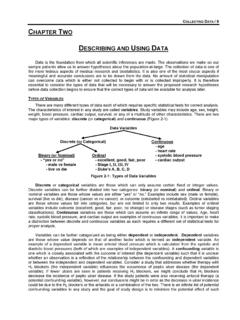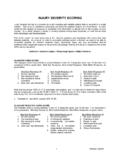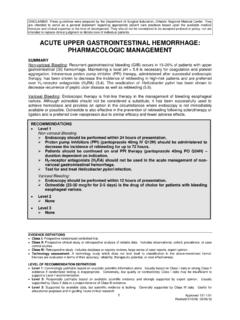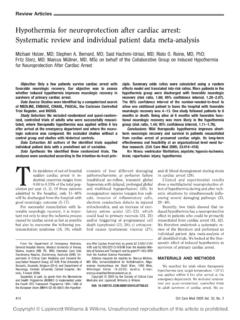Transcription of ICU SEDATION GUIDELINES - SurgicalCriticalCare.net
1 DISCLAIMER: These GUIDELINES were prepared by the Department of Surgical Education, Orlando Regional Medical Center. They are intended to serve as a general statement regarding appropriate patient care practices based upon the available medical literature and clinical expertise at the time of development. They should not be considered to be accepted protocol or policy, nor are intended to replace clinical judgment or dictate care of individual patients. THERAPEUTIC hypothermia . SUMMARY. Therapeutic hypothermia by conventional cooling methods after cardiac arrest has been shown to attenuate neurologic damage and improve survival. Standard therapeutic hypothermia consists of cooling the patient to 32-34 C for 24 hours.
2 Although many trauma patients who develop cardiac arrest may not be candidates for therapeutic hypothermia due to the risk of either worsening or contributing to coagulopathy, it should be considered in patients without significant contraindication. RECOMMENDATIONS. Level 1. Comatose adult patients with out-of-hospital ventricular fibrillation or ventricular tachyarrhythmia cardiac arrest, and a presumed cardiac cause of the arrest, should be cooled to 33 C for 24 hours. Level 2. Comatose adult patients with an out-of-hospital asystolic cardiac arrest should be cooled to 33 C for 24 hours. Comatose adult patients with an out-of-hospital cardiac arrest not from a presumed cardiac cause should be cooled to 33 C for 24 hours.
3 Level 3. Comatose adult patients with an out-of-hospital cardiac arrest from asphyxiation should be cooled to 33 C for 24 hours. Comatose adult patients with an in-hospital cardiac arrest should be cooled to 33 C for 24 hours. In patients where cooling to 33 C is contraindicated, consider cooling to 36 C for 24. hours. INTRODUCTION. Out-of-hospital cardiac arrest is associated with poor survival and poor neurological outcomes. Cerebral reperfusion results in the generation of free radicals and other mediators that trigger chemical cascades resulting in further damage to the brain. Therapeutic hypothermia acts via multiple pathways to reduce brain cell death, including inhibiting the release and uptake of glutamate and dopamine, preservation of the blood brain barrier, continuation of ATP stores, and restitution of the microcirculation (1).
4 Therapeutic hypothermia is a relatively recent concept with many details still to be determined. Although there is relatively good evidence of benefit in comatose patients with an out-of-hospital ventricular fibrillation or tachyarrhythmia from a cardiac cause, there is limited data regarding other initial rhythms and non-cardiac causes of arrest. Additionally, there are limited studies regarding the temperature and duration for therapeutic hypothermia . The current American Heart Association GUIDELINES are as follows: EVIDENCE DEFINITIONS. Class I: Prospective randomized controlled trial. Class II: Prospective clinical study or retrospective analysis of reliable data. Includes observational, cohort, prevalence, or case control studies.
5 Class III: Retrospective study. Includes database or registry reviews, large series of case reports, expert opinion. Technology assessment: A technology study which does not lend itself to classification in the above-mentioned format. Devices are evaluated in terms of their accuracy, reliability, therapeutic potential, or cost effectiveness. LEVEL OF RECOMMENDATION DEFINITIONS. Level 1: Convincingly justifiable based on available scientific information alone. Usually based on Class I data or strong Class II. evidence if randomized testing is inappropriate. Conversely, low quality or contradictory Class I data may be insufficient to support a Level I recommendation. Level 2: Reasonably justifiable based on available scientific evidence and strongly supported by expert opinion.
6 Usually supported by Class II data or a preponderance of Class III evidence. Level 3: Supported by available data, but scientific evidence is lacking. Generally supported by Class III data. Useful for educational purposes and in guiding future clinical research. 1 Approved 02/24/2016. We recommend selecting and maintaining a constant target temperature between 32 C. and 36 C for those patients in whom temperature control is used (strong recommendation, moderate-quality evidence). Whether certain subpopulations of cardiac arrest patients may benefit from lower (32 C 34 C) or higher (36 C) temperatures remains unknown, and further research may help elucidate this. We recommend Targeted Temperature Management (TTM) as opposed to no TTM for adults with out-of- hospital cardiac arrest (OHCA) with an initial shockable rhythm who remain unresponsive after return of spontaneous circulation (ROSC) (strong recommendation, low-quality evidence).
7 We suggest TTM as opposed to no TTM for adults with OHCA with an initial non-shockable rhythm who remain unresponsive after ROSC (weak recommendation, very-low-quality evidence). We suggest TTM as opposed to no TTM for adults with in- hospital cardiac arrest (IHCA) with any initial rhythm who remain unresponsive after ROSC (weak recommendation, very-low-quality evidence). In making these recommendations, we place a higher value on the potential for increased survival with good neurologic outcome as compared with the possible risks (which appear to be minimal) and the cost of TTM. We emphasize that the mortality after cardiac arrest is high and the treatment options are limited. Although the evidence for TTM compared with no temperature management is of low quality, it is the only post-ROSC intervention that has been found to improve survival with good neurologic outcome.
8 We have, therefore, made our recommendation strong in spite of the low-quality evidence. (2). In the trauma population, therapeutic hypothermia may be limited due to concerns for either worsening or contributing to coagulopathy. However, it does have a potential role in patients with cardiac arrest due to asphyxia without other associated injuries. LITERATURE REVIEW. Bernard et al. performed a randomized, controlled trial to compare moderate hypothermia to normothermia after out-of-hospital cardiac arrest. All patients had ventricular fibrillation as the first recorded rhythm and remained comatose after return of spontaneous circulation. hypothermia was initiated in the field by application of cold packs and furthered upon arrival.
9 Patients randomized to hypothermia were maintained at 33 C for 12 hours. At 18 hours, patients were actively rewarmed over 6. hours. Patients randomized to normothermia were maintained at 37 C. 77 patients were included in the study; 43 were treated with hypothermia . 49% of patients treated with hypothermia had a good outcome, defined as discharge to home or rehabilitation, compared to 26% of normothermic patients, resulting in an odds ratio for good outcome with hypothermia of There was no reported difference in adverse effects (3). The hypothermia after Cardiac Arrest Study Group performed a multicenter, randomized, controlled trial to compare moderate hypothermia to normothermia after out-of-hospital cardiac arrest.
10 All patients had ventricular fibrillation or nonperfusing ventricular tachycardia as the first recorded rhythm. hypothermia was initiated upon hospital arrival with an external cooling device to a target temperature of 32 to 34 C, which was maintained for 24 hours, followed by passive rewarming. Patients randomized to normothermia were maintained at 37 C. 273 patients were included in the study; 136 were treated with hypothermia . 55% of patients treated with hypothermia had a good outcome, defined as Pittsburgh cerebral- performance category of 1 (good recovery) or 2 (moderate disability), compared to 39% of normothermic patients, resulting in a risk ratio of Six-month mortality was 42% in the hypothermia group and 55%.










